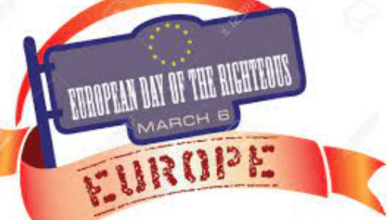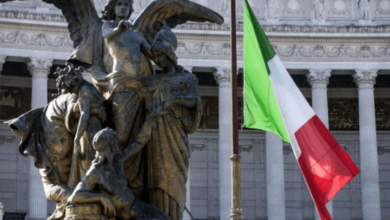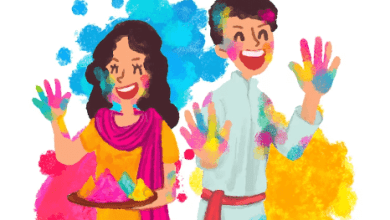Embark on a journey through the heart of Romania as we unravel the mysteries and joys of Mărțișor Day. From ancient traditions to modern celebrations, explore the magic that marks the arrival of spring in Romania.
Read also:
Quick Facts
- Date: March 1st
- Main Components: A red and white string with a pendant attached to it, worn or given as a gift
- Popularity: Celebrated in Romania, Moldova, and other countries in Southeastern Europe
- Pairings: Flowers, coins, clovers, horseshoes, hearts, crosses, etc.
- Variations: Different names, symbols, and customs depending on the region and culture
Introduction
Spring is a season of renewal, rebirth, and joy. It is a time when nature awakens from its long winter sleep and bursts into life and color. It is also a time when people celebrate the return of the sun, the warmth, and the fertility of the earth. One of the most ancient and beautiful spring celebrations in the world is Mărțișor, a traditional festival that takes place on March 1st in Romania, Moldova, and other countries in Southeastern Europe.
Mărțișor (pronounced mərt͡siˈʃor) is a diminutive of Martie, the old folk name for March, which comes from the Latin Martius, the month dedicated to Mars, the Roman god of war and agriculture. Mărțișor is also the name of the main symbol of this festival, a red and white string with a pendant attached to it, which is worn around the neck or pinned to the lapel, or given as a gift to loved ones, especially women and children, as a token of appreciation, respect, and admiration.
The red and white string represents the opposition and unity of opposites: winter and spring, cold and warmth, darkness and light, death and life, war and peace, etc. The pendant can have various shapes and meanings, such as coins for wealth, flowers for beauty, clovers for luck, horseshoes for protection, hearts for love, crosses for faith, etc. The Mărțișor is worn until the end of March, when it is tied to a fruit tree branch or a rose bush, or thrown into a river, as a sign of gratitude and hope for a fruitful and prosperous year.
The purpose of this essay is to explore the history, legend, and tradition of Mărțișor, and to show how this ancient festival has survived and evolved over time, incorporating elements from different cultures and religions, and reflecting the diversity and richness of the Southeastern European region.
History of Mărțișor
The origin of Mărțișor can be traced back to the Dacians, the ancestors of the Romanians, who lived in the Carpathian Mountains and the Danube River basin in the 1st millennium BC. The Dacians celebrated the New Year on March 1st, which marked the beginning of the agricultural cycle and the rebirth of nature. They wore white and red wool threads around their wrists, necks, or waists, as talismans for protection, health, and fertility. The white symbolized the purity and innocence of the snow, while the red symbolized the blood and vitality of the earth.
The Dacians were conquered by the Romans in the 2nd century AD, and their culture and religion were influenced by the Roman civilization. The Romans introduced the cult of Mars, the god of war and agriculture, who was also the father of Romulus and Remus, the legendary founders of Rome. The month of March (Martius) was dedicated to Mars, and it was the first month of the Roman calendar. The Romans celebrated various festivals in honor of Mars, such as the Matronalia, the Equirria, and the Quinquatrus, which involved sacrifices, games, processions, and gifts. The Romans also adopted the Dacian custom of wearing white and red wool threads, which they called funia Martialis (Mars’ rope), as a symbol of victory and fertility.
Mărțișor evolved over time, incorporating elements from other cultures and religions that came into contact with the Southeastern European region, such as the Thracians, the Greeks, the Bulgarians, the Turks, the Aromanians, the Gagauz, the Moldovans, the Macedonians, and the Christians. Mărțișor became a syncretic festival that celebrated the arrival of spring, the resurrection of Christ, the liberation from Ottoman rule, the unity of the Romanian people, and the diversity of the Southeastern European communities.
Legend of Mărțișor
There are many legends and stories associated with Mărțișor, but the most popular one involves a brave young man who fought a dragon to free the sun and bring back spring to the earth. The legend goes like this:
Once upon a time, there was a young man who loved the sun more than anything else. He would wake up every morning and greet the sun with a smile and a song. He would admire the sun’s rays, which brought light and warmth to the world. He would follow the sun’s path, which showed him the way to adventure and discovery.
One day, a terrible dragon came from the depths of the earth and kidnapped the sun. He took the sun to his dark and cold cave, where he locked it in a chest. The dragon was jealous of the sun’s beauty and power, and he wanted to keep it for himself. He also wanted to plunge the world into darkness and despair, and to make the people suffer and fear him.
Related: Engineer’s Day In Panama 2023
Without the sun, the world became a gloomy and dreary place. The sky was covered with clouds, the wind was howling, the rain was pouring, and the snow was falling. The plants withered, the animals hid, and the people shivered. The seasons stopped changing, and it was winter all year round.
The young man was heartbroken and angry. He decided to rescue the sun and restore the natural order. He took his sword and his shield, and he set off to find the dragon’s cave. He searched high and low, far and wide, until he finally reached the dragon’s lair.
He challenged the dragon to a fight, and the battle began. The young man and the dragon fought fiercely, exchanging blows and wounds. The young man was brave and strong, but the dragon was cunning and powerful. The fight lasted for days and nights, until the young man managed to strike the dragon’s heart with his sword, and the dragon fell dead.
The young man then opened the chest and freed the sun. The sun was overjoyed and grateful, and it shone brightly again. The sun’s rays pierced the clouds, melted the snow, dried the rain, and warmed the wind. The plants sprouted, the animals came out, and the people rejoiced. The seasons started changing again, and spring returned to the earth.
However, the young man was mortally wounded by the dragon, and his blood dripped on the snow, creating red and white flowers, which he picked and gave to a beautiful maiden who was watching him from afar. The maiden was the daughter of the earth, and she had fallen in love with the young man at first sight. She wore the flowers as a necklace, and she rushed to his side, hoping to save him.
But it was too late. The young man died in her arms, and she cried bitterly. She kissed him goodbye, and she buried him under a cherry tree, which blossomed with pink flowers. She then became the symbol of spring, while he became the symbol of winter. And every year, on March 1st, she would wear the red and white flowers, which were called Mărțișor, to remember him and to honor his sacrifice.
Related: Remembrance Day In Marshall Islands 2023
Tradition of Mărțișor
Mărțișor is celebrated today in different regions and countries, with different names, symbols, and customs, depending on the local culture and tradition. However, some common elements can be identified, such as the red and white string, the pendant, the gift, and the celebration of spring.
The red and white string is the most characteristic feature of Mărțișor, and it has various interpretations and meanings. Some say that it represents the blood and the milk of the earth, which nourish the crops and the cattle. Others say that it represents the fire and the water, which purify and regenerate the world. Others say that it represents the love and the friendship, which bind the people together.
The pendant can have various shapes and meanings, depending on the preference and the imagination of the giver and the receiver. Some of the most common pendants are:
- Coins: They symbolize wealth, prosperity, and good fortune. They are usually made of gold or silver, and they are sometimes engraved with the year or the name of the person.
- Flowers: They symbolize beauty, freshness, and joy. They are usually made of natural or artificial materials, and they are sometimes scented or colored. The most popular flowers are snowdrops, which are the first to bloom in spring, and symbolize hope and purity.
- Clovers: They symbolize luck, happiness, and success. They are usually made of green or red materials, and they are sometimes decorated with beads or sequins. The most sought-after clovers are the four-leaf ones, which are rare and considered to be very lucky.
- Horseshoes: They symbolize protection, strength, and power. They are usually made of metal or wood, and they are sometimes painted or carved. The most effective horseshoes are the ones that have been worn by a horse, which are believed to have magical properties.
- Hearts: They symbolize love, affection, and romance. They are usually made of red or pink materials, and they are sometimes embellished with lace, ribbons, or pearls. The most romantic hearts are the ones that have a personal message or a name written on them.
- Crosses: They symbolize faith, spirituality, and protection. They are usually made of wood or metal, and they are sometimes adorned with beads, crystals, or flowers. The most sacred crosses are the ones that have been blessed by a priest or a monk.
MARTISOR DAY IN ROMANIA WISHES, QUOTES, AND MESSAGES
TOP 20 MARTISOR DAY IN ROMANIA WISHES AND GREETINGS
Here are 20 unique Mărțișor Day wishes and greetings for Romania:
- “Wishing you a Mărțișor Day filled with joy, good health, and the promise of spring’s renewal.”
- “May your Mărțișor bring you happiness and good luck, just like the vibrant flowers that bloom in the spring.”
- “Happy Mărțișor Day! May the red and white threads symbolize the balance of life, and may your days be as bright as the spring sun.”
- “On this special day, may the Mărțișor around your wrist bring you prosperity, love, and countless beautiful moments.”
- “Sending you warm wishes on Mărțișor Day! May the coming spring fill your life with new beginnings and endless possibilities.”
- “May your Mărțișor be a token of good fortune, and may the beauty of this day linger in your heart throughout the year.”
- “Wishing you a Mărțișor Day as delightful as the blossoming flowers and as colorful as the traditional red and white threads.”
- “Happy Mărțișor! May this day mark the start of a season filled with love, laughter, and the sweet fragrance of spring.”
- “May the red and white threads of Mărțișor weave a tapestry of happiness and prosperity in your life. Happy Mărțișor Day!”
- “On Mărțișor Day, may your heart be as light as a feather, and may the beauty of this tradition bring you joy and good luck.”
- “Sending you Mărțișor Day wishes filled with the warmth of friendship, the joy of spring, and the promise of new beginnings.”
- “Happy Mărțișor Day! May the threads of good fortune wrap around you, bringing health, happiness, and success in all your endeavors.”
- “Wishing you a Mărțișor Day that’s as bright and cheerful as the blooming flowers, and as hopeful as the first rays of spring.”
- “May the red and white threads of Mărțișor weave a tapestry of love, happiness, and success in the coming year. Happy Mărțișor Day!”
- “On this Mărțișor Day, may the beauty of tradition fill your heart with joy, and may the promise of spring bring renewed hope and positivity.”
- “Happy Mărțișor! May the red and white threads symbolize the balance of life and bring you good luck, love, and prosperity.”
- “Wishing you a Mărțișor Day that’s as vibrant and colorful as the flowers in bloom, and as joyful as the laughter of friends and family.”
- “May your Mărțișor Day be adorned with moments of happiness, the fragrance of spring, and the warmth of cherished friendships.”
- “Happy Mărțișor! May the red and white threads on your wrist bring you luck, love, and the promise of a beautiful spring ahead.”
- “On this Mărțișor Day, may the threads of tradition weave a tapestry of joy and prosperity, and may the coming spring bring you endless blessings.”
TOP 20 MARTISOR DAY IN ROMANIA QUOTES
Here are 20 unique Mărțișor Day quotes for Romania:
- “As the Mărțișor threads weave their way into our lives, may they bring a tapestry of hope, love, and the promise of a vibrant spring.”
- “Mărțișor Day is a reminder that even the simplest threads can carry the weight of tradition, bringing luck and renewal into our lives.”
- “In the red and white threads of Mărțișor, we find the colors of a new beginning, a fresh start, and the beauty of Romanian traditions.”
- “On Mărțișor Day, let the threads symbolize the strength of our bonds, the resilience of our spirit, and the joy of shared traditions.”
- “Like the threads of Mărțișor, may our connections be strong, our days be bright, and our hearts be filled with the warmth of tradition.”
- “Mărțișor is not just a symbol; it’s a reminder that life, like the changing seasons, is a beautiful and continuous cycle of renewal.”
- “As we celebrate Mărțișor Day, let the threads be a metaphor for the ties that bind us, connecting our past, present, and future.”
- “In the simplicity of Mărțișor, we find the profound beauty of tradition and the enduring spirit of a culture that celebrates life.”
- “The red and white threads of Mărțișor carry the whispers of nature’s rebirth, echoing the hope and promise of a brighter tomorrow.”
- “Mărțișor Day teaches us that even the smallest traditions can carry the weight of centuries, connecting us to our roots and shaping our destiny.”
- “As we wear the Mărțișor, let it be a symbol of resilience, a testament to the strength that comes from embracing our heritage.”
- “May Mărțișor Day inspire us to weave our dreams into the fabric of reality, creating a tapestry of success, joy, and fulfillment.”
- “In the threads of Mărțișor, we find the silent poetry of tradition, a language that speaks of our shared history, resilience, and unity.”
- “Mărțișor is a celebration of the enduring spirit of Romania, where tradition intertwines with modernity, creating a colorful mosaic of life.”
- “Wearing the Mărțișor is like carrying a piece of Romanian tradition with us, a reminder that our roots are as strong as the bonds we create.”
- “On Mărțișor Day, let us embrace the threads of change, weave them into our lives, and celebrate the beauty that comes with each passing season.”
- “The red and white threads of Mărțișor symbolize the dichotomy of life – the joy and challenges, the yin and yang that make our journey complete.”
- “Mărțișor Day is a celebration of our shared heritage, a reminder that traditions are the threads that bind us to our past and guide us into the future.”
- “As we exchange Mărțișor wishes, let us also exchange the warmth and kindness that define the spirit of this beautiful Romanian tradition.”
- “Mărțișor is a tiny masterpiece, a thread of culture that ties us to the rich tapestry of Romania’s history, reminding us to cherish our roots.”
TOP 20 MARTISOR DAY IN ROMANIA MESSAGES/SMS
Here are 20 unique Mărțișor Day messages for Romania:
- “On Mărțișor Day, may the red and white threads usher in a season of joy, prosperity, and the blossoming of new opportunities. Happy Mărțișor Day!”
- “Wishing you a Mărțișor Day filled with the beauty of tradition, the warmth of friendship, and the promise of a radiant spring ahead.”
- “Happy Mărțișor Day! May the threads of this cherished tradition wrap you in good luck, love, and the vibrant colors of a Romanian spring.”
- “As you wear the Mărțișor, may it bring you the renewal of hope, the warmth of shared traditions, and the brightness of a promising future.”
- “On Mărțișor Day, let the red and white threads remind you of the enduring spirit of Romania, weaving together our past, present, and the dreams of tomorrow.”
- “May the threads of Mărțișor Day be the ties that bind us in friendship, love, and the shared pride of celebrating our beautiful Romanian heritage.”
- “Happy Mărțișor Day! May the threads around your wrist be a constant reminder of the resilience, beauty, and unity that define our culture.”
- “Wishing you a Mărțișor Day filled with laughter, love, and the promise of a season where every day unfolds like the petals of a blooming flower.”
- “On this Mărțișor Day, may the threads symbolize the tapestry of happiness that weaves through your life, creating a masterpiece of cherished moments.”
- “As the red and white threads intertwine, may they bring you luck, prosperity, and the boundless joy that comes with celebrating Mărțișor Day.”
- “Happy Mărțișor Day! May the threads of tradition weave a story of resilience and cultural richness, creating a vibrant tapestry in your life.”
- “Wishing you a Mărțișor Day filled with the fragrance of spring, the warmth of tradition, and the excitement of new beginnings.”
- “May Mărțișor Day be a celebration of the ties that connect us—friendship, family, and the shared pride of being part of Romania’s rich heritage.”
- “On this special day, may the red and white threads of Mărțișor be a reminder that life, like the changing seasons, is a constant journey of renewal and growth.”
- “Happy Mărțișor Day! May the threads symbolize the tapestry of joy that surrounds you, making each moment a unique and beautiful part of your story.”
- “Wishing you a Mărțișor Day as vibrant and colorful as the threads that adorn it, filled with laughter, love, and the promise of a flourishing spring.”
- “May the red and white threads of Mărțișor be the bridge between tradition and modernity, connecting us to our roots while embracing the excitement of the future.”
- “Happy Mărțișor Day! May the threads carry with them the essence of Romanian resilience, culture, and the timeless beauty of our traditions.”
- “On this Mărțișor Day, may the threads around your wrist be a beacon of hope, radiating the positive energy that comes with celebrating the richness of Romanian culture.”
- “Wishing you a Mărțișor Day filled with the magic of tradition, the sweetness of shared moments, and the anticipation of a springtime filled with blessings and joy.”
Conclusion
Mărțișor is one of the most ancient and beautiful spring celebrations in the world. It is a festival that has its roots in the Dacian and Roman civilizations, and that has evolved over time, incorporating elements from different cultures and religions. It is a festival that reflects the diversity and richness of the Southeastern European region, and that showcases the creativity and craftsmanship of its people. It is a festival that honors the women and girls, who are the symbols of spring, beauty, and life, and that expresses the appreciation, respect, and admiration of the men and boys, who are the protectors and supporters of their families and communities.
Mărțișor is a festival that I personally enjoy and cherish, as it connects me with my identity and heritage. It reminds me of my childhood, when I would receive Mărțișor from my parents, grandparents, and friends, and when I would wear them with pride and joy. It also reminds me of my culture, when I would visit the Mărțișor fairs and markets, and when I would admire the variety and beauty of the Mărțișor accessories. It also reminds me of my values, when I would give Mărțișor to my loved ones, and when I would express my gratitude, love, or friendship.
Mărțișor is a festival that I would recommend to anyone who wants to learn more about the Southeastern European region, and to experience its charm and spirit. There are many ways to do so, such as visiting the Mărțișor fairs and markets, where one can find and buy Mărțișor accessories, or watching the documentaries and films, where one can see and hear the stories and legends of Mărțișor. There are also many books and articles, where one can read and learn about the history and tradition of Mărțișor. And of course, there are many people, who are willing and happy to share and celebrate Mărțișor with anyone who is interested and curious.
Mărțișor is a festival that celebrates the arrival of spring, the rebirth of nature, and the renewal of life. It is a festival that brings joy, hope, and peace to the world. It is a festival that I love and respect, and that I hope you will love and respect too. Happy Mărțișor Day!



